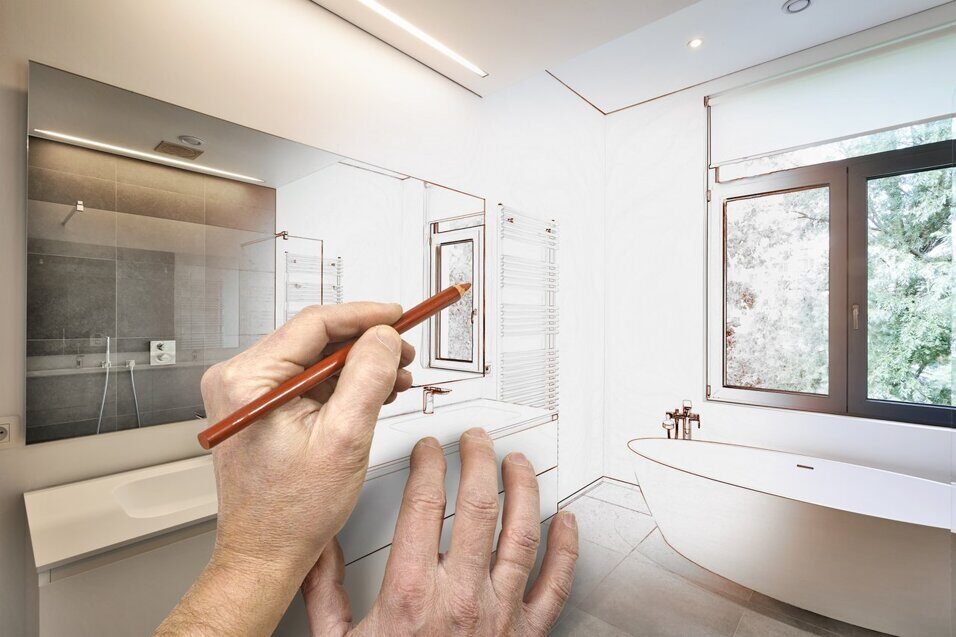Mold-Free Bathroom Renovation is a common and unwelcoming problem. It thrives in the warm, humid environment of showers, baths, and poor ventilation. It is unsightly, and mold can pose health risks, triggering allergies, asthma, and other respiratory issues. If you’re planning a bathroom renovation, it’s the perfect opportunity to take proactive steps to prevent mold growth and create a healthy, hygienic space. This comprehensive guide will provide expert tips, tricks, and advice to achieve a mold-free bathroom that you can enjoy for years to come.
Why Mold-Free Bathroom Renovation?
Before we jump into the renovation process, let’s take a moment to learn about why bathrooms are so prone to mold growth. You can find mold spores just about anywhere, whether inside or outside. They make more of themselves by letting out tiny spores that float around in the air. So, when these spores find a damp spot with some organic stuff like soap scum, dust, or even drywall, they start to grow.
Bathrooms provide the ideal conditions for mold proliferation:
- Moisture: Showers, baths, and leaky pipes or faucets introduce significant amounts of moisture into the air and onto surfaces.
- Humidity: The warm, moist air in bathrooms creates high humidity levels, encouraging mold growth.
- Poor Ventilation: Inadequate ventilation traps moisture and humidity, creating a breeding ground for mold.
- Organic Materials: Soap scum, dust, hair, and even the paper facing on drywall can serve as food sources for mold.
Planning Your Mold-Free Bathroom Renovation
A successful mold-free bathroom renovation starts with careful planning. Here are key considerations:
- Identify and Address Existing Mold Issues:
If your bathroom has mold, start any renovation work. A mold-essential cleaner can be used for small areas. However, it’s best to consult a professional mold remediation service for large infestations.
- Prioritize Ventilation:
Good ventilation is key to keeping mold at bay. Make sure your bathroom has an appropriately sized exhaust fan that vents outside. You could also install a fan with a humidistat, which will kick on automatically when the humidity levels rise.
- Choose Mold-Resistant Materials:
Select materials that are less susceptible to mold growth:
- Tiles: Porcelain and ceramic tiles are naturally water-resistant and easy to clean, making them excellent walls and floors.
- Grout: Use epoxy grout, which is more resistant to water and stains than traditional cement-based grout. Consider using darker-colored grout, as it tends to show mold less readily.
- Paint: Opt for mold-resistant paint formulated explicitly for bathrooms. These paints contain mildewcides that inhibit mold growth.
- Drywall: In moisture-prone areas, such as shells, use moisture-resistant drywall (often called “green board”).
- Seal and Waterproof:
Proper sealing and waterproofing are crucial to prevent water from penetrating walls and floors:
- Caulk: Apply caulk around tubs, showers, sinks, and countertops to seal gaps and prevent water intrusion. Use a high-quality mildew-resistant caulk.
- Waterproofing Membranes: Install a waterproofing membrane behind the tile in shower and tub areas to create an extra layer of protection.
Step-by-Step Renovation Tips for Mold Prevention
Here’s a detailed breakdown of renovation steps with a focus on mold prevention:
- Demolition and Mold Remediation: If necessary, carefully remove existing fixtures, tiles, and drywall. If mold is present during demolition, take appropriate precautions and consider professional remediation if the infestation is extensive.
- Plumbing and Ventilation: Ensure all plumbing is in good condition and leak-free. Install or upgrade your exhaust fan, ensuring it’s appropriately sized for the bathroom and vents to the outside.
- Framing and Drywall: If you’re altering the layout or replacing drywall, use moisture-resistant drywall in areas prone to moisture. Ensure proper framing to create a solid base for tile and fixtures.
- Waterproofing: Follow the manufacturer’s instructions to apply a waterproofing membrane to shower and tub areas. This crucial step prevents water from seeping into the wall cavity.
- Tiling and Grouting: Install tile using a high-quality thin-set mortar. Use epoxy grout for its superior water resistance. Seal the grout after it cures to enhance its protection further.
- Painting: Paint the walls and ceiling with mold-resistant paint. Ensure the surfaces are clean and dry before painting.
- Fixtures and Finishes: Install new fixtures, such as the toilet, sink, and shower or tub. To seal gaps, apply mildew-resistant caulk around all fixtures.
Ongoing Maintenance for a Mold-Free Bathroom
Even with a mold-resistant renovation, regular maintenance is essential to keep your bathroom mold-free:
- Ventilate: Always run the exhaust fan during and after showers or baths to remove moisture and humidity.
- Clean Regularly: Clean the bathroom regularly to remove soap scum, dirt, and other organic materials that can serve as food sources for mold.
- Dry Surfaces: Wipe down wet surfaces, such as shower walls and doors, after each use.
- Check for Leaks: Regularly inspect plumbing fixtures and pipes for leaks and address them promptly.
- Monitor Humidity: Monitor humidity levels in the bathroom. If they are consistently high, consider using a dehumidifier.
Expert Advice for Long-Term Mold Prevention
- Consider a Window: Include a window in your bathroom design for natural ventilation and light.
- Use a Squeegee: Keep a squeegee in the shower and use it to remove water from the walls and door after each use.
- Wash Bath Mats and Rugs Regularly: Wash bath mats and rugs frequently to prevent mold growth.
- Avoid Storing Wet Items: Don’t leave wet towels or clothes on the floor or in the bathroom.
Conclusion
A mold-free bathroom renovation is an investment in your health and home. By understanding the factors contributing to mold growth and taking proactive steps during the renovation process, you can create a beautiful, hygienic space that you can enjoy for years to come.
Remember to prioritize ventilation, choose mold-resistant materials, and maintain your bathroom regularly to prevent mold from returning. With careful planning and consistent maintenance, you can achieve a mold-free bathroom that enhances your well-being and adds value to your home.







